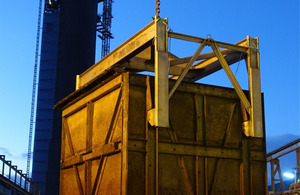It’s been a massive effort in challenging times
Praise for employees and supply chain as Sellafield Ltd hits clean-up milestone

Waste skip being exported out of the Pile Fuel Storage Pond
One of the UK’s most important nuclear decommissioning projects has taken a giant leap forward.
Workers at Sellafield’s Pile Fuel Storage Pond have now removed half of the solid waste in the facility.
It puts the programme on track to remove almost all radioactive material by 2024.
That would complete a task that began more than a decade ago and retire one of the UK’s biggest nuclear risks.
Even more impressive, the job was finished during the COVID-19 pandemic, using new ways of working to protect people from the virus.
Dorothy Gradden, head of legacy ponds for Sellafield Ltd, said:
I’m very proud we’ve kept our retrievals operations going during a very challenging year.
The dedication and determination of the whole team to deliver this milestone is something we’ll remember for years to come.
It’s been a massive effort in challenging times from the Sellafield Ltd team and our supply chain partners.
There’s still a huge amount to do but the experience and techniques we’ve built up should make the second half of the job simpler and quicker.
The Pile Fuel Storage Pond was built in the 1940s to help produce plutonium for Britain’s nuclear deterrent, Sellafield’s original mission.
It was prioritised for clean-up by the Nuclear Decommissioning Authority in the early 2000s, along with 3 other Sellafield facilities collectively known as the legacy ponds and silos.
An open-air storage pond, it was used to keep spent nuclear taken from Sellafield’s Windscale Pile reactors.
In 2016, the last of its fuel inventory was retrieved, removing 70% of its radioactive inventory.
Getting solid waste like old equipment out of the pond began in 2010. There was an estimated 750 tonnes in the facility originally. The latest milestone means less than 375 tones remain.
Why is this work important?
While crucial in itself, getting this solid waste out has another important benefit.
It frees up floor space to remove material like sludge and debris, meaning the overall rate of retrievals can accelerate.
That acceleration means the pond should be clear of almost all radioactive material by 2024. It will then be ready to be drained of water. The building itself can then also be decommissioned.
If things progress as planned, the pond should be fully drained of water by 2029. The entire facility will then be decommissioned and demolished.
Why is this work challenging?
The work involves removing equipment previously used for underwater fuel reprocessing operations. This is surrounded by radioactive sludge.
Each item has to be assessed for the most suitable and cost-effective route for disposal or storage.
Some are sent to more modern plants at Sellafield for storage, pending final disposal. Items with low levels of radioactivity are disposed of at the UK’s Low Level Waste Repository.
How was it achieved?
The initial focus of the pond clean-up programme was removing the nuclear fuel stored underwater in skips.
‘Mobile’ sludge (sludge that isn’t fixed to a surface) was also an early target. That’s because these items contained most of the radioactivity.
After the fuel was removed in 2016, focus switched to taking out the solid waste.
Remotely operated vehicles have been vital. They ‘swim’ around the pond and can inspect, map, pick up, and move items. They also help deploy bigger tools which can cut up and lift the waste out.
A JCB micro digger was even lowered in at one point to help cut, sort, and segregate the solid waste.
Overhead, a skip handler machine was repurposed to help remove waste. It has successfully completed 3,000 moves to support decommissioning.